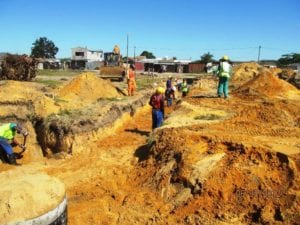Role players within the sphere of infrastructure delivery and construction should expect the parameters in which they have operated over the last three years to remain as certain as death and taxes during 2013, writes Richard Jansen van Vuuren.
The good news about this is that no one in the private sector is going to be surprised outside of their planned strategies and that those employed in the public sector can expect to continue to strive in their efforts addressing backlog and maintenance on a shoe-string budget. This must be hugely frustrating, especially knowing that the hundreds of billion rand available from government remain bound in the bonds of bureaucracy. But what exactly are the challenges within the infrastructure delivery and construction chain that are to be met this year if significant progress is to be made? Starting at the topThe Department of Performance, Monitoring and Evaluation, which falls under the Presidency, exists to assist the executive to monitor and evaluate itself. It has put in several monitoring and evaluation processes since its inception in 2010. However, despite this, it has been criticised for failing to ensure that ministers and departments perform to their expectations. The department has also been criticised for not properly communicating government`s service delivery record and successes. Unfortunately, the issue of accountability remains a thorn in the department’s side as it does not have a mandate to sanction ministers and departments and is limited to identifying areas in which government programmes are working or failing. The presidential infrastructure coordinating commission was launched in 2012 following the president`s State of the Nation address, in which it was punted as the new big idea for the economy. Several strategic integrated projects (SIPs) were identified of which a large proportion pertain to issues such as housing, sanitation, delivery of water and road construction. The Minister of Economic Development, Ebrahim Patel, aims to create five million jobs by 2020. When the Department of Housing was renamed as the Department of Human Settlements it empowered the department responsible for not only the construction of housing units but the bigger picture surrounding housing – integrated settlements with adequate power and sanitation. Unfortunately, the department has not indicated a significant interest in working with ministers whose portfolios deal with water, electricity, sanitation and the identification of land. A lack of policy direction and legal uncertainty has been labelled as the cause of this failure. Unbelievably, there is no legislative framework to address this status quo, which is staggeringly incredible for a department that is already four years old. The minister of Human Settlements, Tokyo Sexwale, spent much of 2012 honing ambitious plans for the establishment of a state housing construction company and state housing bank – which remain pipe dreams for the time being. In his defence, it would be remiss not to acknowledge Sexwale’s dealing with the long-standing problem of the M2 Gateway housing problem by relocating 10 000 shack dwellers to housing units. His department has also recognised that in some cases it cannot just remove people from shacks and informal settlements as it has pledged to provide them with water, sanitation and electricity through the national upgrade support programme. The minister of Cooperative Governance and Traditional Affairs, Richard Baloyi, has been widely criticised for delays in finalising regulations and policy, which have stalled the implementation of two critical changes from taking place at a local government level. These are:
– blocking political party office bearers from running municipalities
– demanding minimum standards of training and experience of those who manage local governments. While it may be naïve to assume that these changes would fix the shambles at local government level there would be an ideal starting point from which to address the current challenges that have evolved into medium and long-term problems. Every day that passes without these changes being implemented impacts the state of the country’s infrastructure outlook well into the future. This gloomy atmosphere is highlighted by the unfortunate fact that municipalities continue to decline – the measurable being the number of service delivery protests around the country. On a much more positive note, the largest state-owned enterprises and those most integral to the government`s infrastructure ambitions, such as Transnet and Eskom, are actually running relatively well when compared to recent history. The Department of Public Enterprises with Malusi Gigaba at the helm is establishing a unit to oversee large capital expenditure projects run by the state-owned enterprises and provide additional oversight. This is largely a reaction to the shambles linked to Transnet`s new multi-product pipeline and follows a ministerial review that found many “systemic failings” in the project. Gigaba is a firm believer in using the entities to lead state development. He has been actively involved in the presidential infrastructure coordinating committee that is streamlining the planning of government projects.
The Department of Water Affairs last year finally embraced the idea that South Africa is facing a severe water crisis and has proposed public-private partnerships to bridge the more than R500 million funding deficit required to address this.
The minister of the department, Edna Molewa, endures the frustration of keeping on top of this situation while being constantly aware that even if she achieves the almost impossible task, she will have to find a way to force local government to take up the slack and start spending some of its budget on infrastructure. Ultimately, she is responsible for ensuring water gets to where it needs to be but municipalities have to deliver it to the communities they serve. When Thulas Nxesi inherited the Department of Public Works, the Special Investigating Unit had just revealed depressing levels of graft within it and the auditor general had handed the department an audit disclaimer. The department was in a dire state. Nxesi stated at the time of his appointment that in seven years there had been nine different directors’ general and acting directors general and five different ministers in the department. Despite this tainted past, Nxesi has made a credible start at cleaning up the mess. The first steps he took involved him publicly acknowledging the problems: poor management and weak controls were fuelling corruption, 35 000 properties were unaccounted for and 3 000 poorly managed and expensive leases were draining public money. He also instituted a “turnaround strategy”; including a core team reporting to the director general’s office to address issues and how to fix the department’s deep faults without interrupting services. What it all meansIn his 2012 presidential address, Jannie Pietersen outlined that Trevor Manuel, head of the National Planning Commission and president Jacob Zuma, had both called on South Africans to offer their efforts, time and skills as individuals and citizens of the country to realise that in order to solve our problems, we need to do things differently. “It is always tempting to believe that throwing money at a problem will solve it. The implication for municipal engineers in South Africa is that we need to change from being “engineers with technical skills” to becoming “engineers for change”. As municipal engineers we have the privilege of being able to improve the lives and well-being of all South Africans particularly the most vulnerable in society: the poorest of the poor and the children – our citizens of tomorrow,” stated Pietersen. “IMESA has an important leadership role to play. We can contribute towards positive change in South Africa by changing our own mindset from one of “we are engineers” to a more significant “we are mentors who support municipalities in engineering their own change”. In sharing knowledge we improve skills. In improving skills we enhance the running of our municipalities. In developing the capacity and effectiveness of one municipality at a time, we can transform the lives of many,” maintains Pietersen. Speaking at the IMESA Conference 2012, Naren Bhojaram, the then president of Consulting Engineers South Africa, outlined how municipal engineers need to re-establish their profession within the challenging confines of the current sector. Bhojaram outlined the evolution of the municipal engineering fraternity as being strongly influenced by the training of engineers over the past five decades:
1970s and 1980s: municipalities and parastatals were the best training grounds for young engineers
1990s: experienced municipal engineers moved to the private sector and municipalities lost their credibility
2000s: the private sector continued to train young engineers
2010s: Price-based competition has resulted in the private sector reducing training and various interventions for training and development of capacity within local authorities failing. Training of young engineers has become non-existent and the profession itself now an unattractive option for learners. All of the points are further compounded by the current circumstances in provincial and municipal planning where integrated development plans hinder actual progress as they are often political wish lists. With the rapid urbanisation of South Africa’s cities expected to continue, Bhojaram posed the question: “Why are we building infrastructure that will last 50 years in rural areas?” Densification of urban areas incorporating integrated solutions should be explored, as should the continued maintenance and expansion of existing urban infrastructure – and these solutions will call for a new generation of experienced municipal engineers devoid of ‘political affiliation’.








